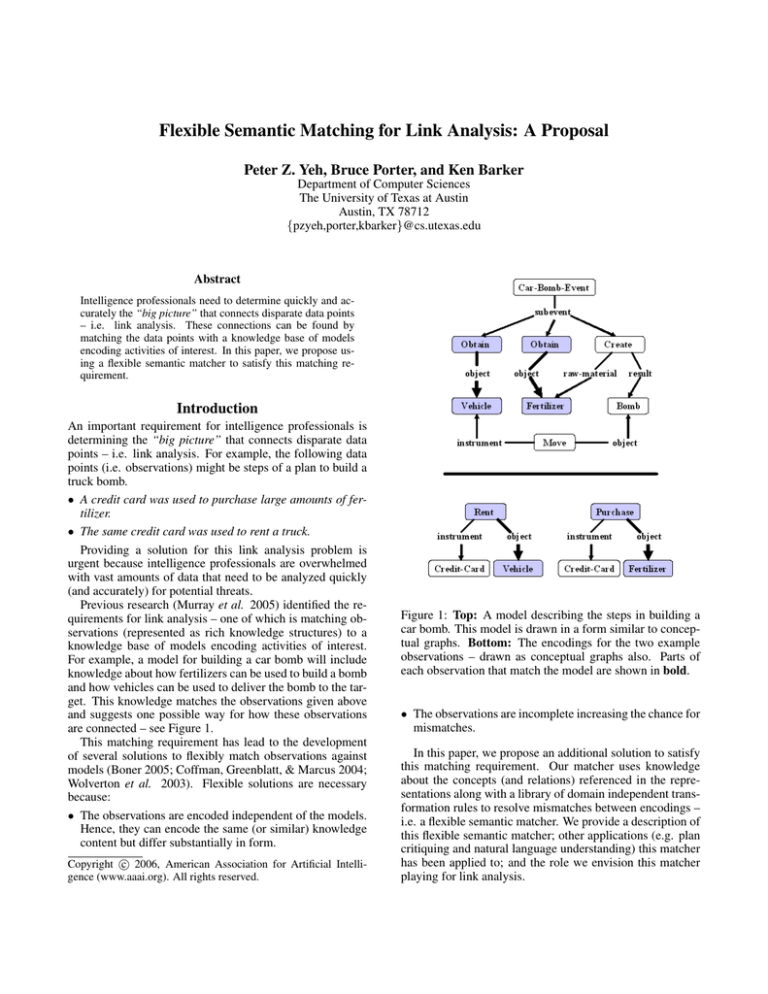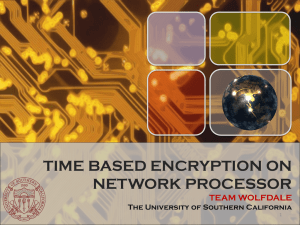
Flexible Semantic Matching for Link Analysis: A Proposal
Peter Z. Yeh, Bruce Porter, and Ken Barker
Department of Computer Sciences
The University of Texas at Austin
Austin, TX 78712
{pzyeh,porter,kbarker}@cs.utexas.edu
Abstract
Intelligence professionals need to determine quickly and accurately the “big picture” that connects disparate data points
– i.e. link analysis. These connections can be found by
matching the data points with a knowledge base of models
encoding activities of interest. In this paper, we propose using a flexible semantic matcher to satisfy this matching requirement.
Introduction
An important requirement for intelligence professionals is
determining the “big picture” that connects disparate data
points – i.e. link analysis. For example, the following data
points (i.e. observations) might be steps of a plan to build a
truck bomb.
• A credit card was used to purchase large amounts of fertilizer.
• The same credit card was used to rent a truck.
Providing a solution for this link analysis problem is
urgent because intelligence professionals are overwhelmed
with vast amounts of data that need to be analyzed quickly
(and accurately) for potential threats.
Previous research (Murray et al. 2005) identified the requirements for link analysis – one of which is matching observations (represented as rich knowledge structures) to a
knowledge base of models encoding activities of interest.
For example, a model for building a car bomb will include
knowledge about how fertilizers can be used to build a bomb
and how vehicles can be used to deliver the bomb to the target. This knowledge matches the observations given above
and suggests one possible way for how these observations
are connected – see Figure 1.
This matching requirement has lead to the development
of several solutions to flexibly match observations against
models (Boner 2005; Coffman, Greenblatt, & Marcus 2004;
Wolverton et al. 2003). Flexible solutions are necessary
because:
• The observations are encoded independent of the models.
Hence, they can encode the same (or similar) knowledge
content but differ substantially in form.
c 2006, American Association for Artificial IntelliCopyright gence (www.aaai.org). All rights reserved.
Figure 1: Top: A model describing the steps in building a
car bomb. This model is drawn in a form similar to conceptual graphs. Bottom: The encodings for the two example
observations – drawn as conceptual graphs also. Parts of
each observation that match the model are shown in bold.
• The observations are incomplete increasing the chance for
mismatches.
In this paper, we propose an additional solution to satisfy
this matching requirement. Our matcher uses knowledge
about the concepts (and relations) referenced in the representations along with a library of domain independent transformation rules to resolve mismatches between encodings –
i.e. a flexible semantic matcher. We provide a description of
this flexible semantic matcher; other applications (e.g. plan
critiquing and natural language understanding) this matcher
has been applied to; and the role we envision this matcher
playing for link analysis.
C1
Event
Event
Event
Event
Event
Event
State
C2
Event
Event
Event
Event
Event
Event
Action
C3
Event
Event
Event
Event
Event
Event
Event
r1
causes
enables
caused-by
enabled-by
inhibited-by
prevented-by
defeated-by
r2
causes
causes
caused-by
caused-by
caused-by
caused-by
caused-by
Event
Event
Event
Event
Event
Event
Event
Event
Event
Event
State
State
State
State
State
State
State
Event
Event
Event
Event
causes
enables
inhibits
caused-by
enabled-by
inhibited-by
prevented-by
resulting-state
resulting-state
resulting-state
resulting-state-of
resulting-state-of
resulting-state-of
resulting-state-of
Event
Event
Event
Event
Event
Event
enables
enabled-by
enables
enabled-by
Event
Event
Event
Event
Event
Event
by-means-of
means-by-which
by-means-of
means-by-which
Table 1: Examples of transformation rules for causal effects between events.
Flexible Semantic Matching
We propose using a flexible semantic matcher to find the
connections between disparate data points.
Description of Matcher
Our semantic matcher takes two knowledge representations
(encoded in a form similar to conceptual graphs (Sowa
1984)) and uses taxonomic knowledge (regarding both concepts and relations) to find the largest connected subgraph
in one representation that is isomorphic to a subgraph in the
other (it ignores degenerate – i.e. single node – subgraphs).
Our matcher then uses a library of about 200 transformation rules to shift the representations to improve the match.
This improvement might enable other (non-degenerate) subgraphs to match isomorphically, which in turn might enable
more transformation rules, and so on until the match improves no further.
This library of transformation rules has two unique features. First, these rules are based on a domain independent
upper ontology called the Component Library (CLib) – see
(Barker, Porter, & Clark 2001). The CLib has about 80 semantic relations and about 500 generic concepts (i.e. events
and entities). These 500 concepts can be composed (and extended) to build domain specific ones. Hence, rules based
on this ontology should be generally useful across a wide
range of applications and domains. Second, these rules are
instances of the pattern “Transfers Thru” (Lenat & Guha
1990) which has the following form:
r
r
r
1
1
2
C3
C1 −→
C2 −→
C3 ⇒ C1 −→
where Ci is a concept and rj is a relation. Transformations
obeying this pattern are pervasive because they handle dif-
ferences in granularity which is a very common cause of
mismatches.
Table 1 gives examples of transformation rules in this library. Each row is an instantiation of the Transfers Thru
pattern that corresponds to a transformation. These rules are
for causal effects between events.
A transformation rule is applicable to a representation if
its antecedent subsumes a subgraph of the representation. A
rule is applied by joining (Sowa 1984) the rule’s consequent
with the subgraph that matched the rule’s antecedent.
Additional details about our matcher can be found in
(Yeh, Porter, & Barker 2003).
Previous Applications
Our semantic matcher has been used in several other applications and domains including:
• Plan Critiquing. We used our matcher to match encodings of desirable (and undesirable) military situations (called patterns) to battle plans to assess the plans’
strengths and weaknesses (Barker et al. 2003). The data
set used in this evaluation was a corpus of battle plans
and critiquing patterns built by two military analysts for
DARPA’s Rapid Knowledge Formation project.
• Discourse Understanding. We used our matcher to
match the utterances in a discourse with background
knowledge to build a deep semantic representation of
what was said (Yeh, Porter, & Barker 2005). The data
set used in this evaluation was a corpus of purchase requisitions for computer equipments.
• Sense Disambiguation and Semantic Role Labeling.
We used our matcher to perform the natural language processing tasks of sense disambiguation and semantic role
labeling by matching candidate interpretations to background knowledge to select the best matching candidate
(Yeh, Porter, & Barker 2006). The data set used in this
evaluation was a corpus of sentences collected from four
domains – i.e. chemistry, pollution prevention, employee
safety, and nuclear deterrence.
In each case, our semantic matcher outperformed the state
of the art by significantly improving recall without loss of
precision. We attributed this improvement to our matcher’s
use of transformation rules to resolve mismatches.
Role in Link Analysis
We envision using our semantic matcher in the following
manner.
Our matcher will match each observation with models encoding activities of interest. The overall score (initially zero)
for each model is updated with the match score between the
model and the observation. This score is computed using:
X
1
÷ |M |
(1)
d(ni , nj ) + 1
(ni ,nj )
where (ni , nj ) is a pair of matched concepts (or relations),
d is the taxonomic distance (i.e. minimum number of steps)
between two concepts (or relations) in an ontology, and |M |
is the total number of concepts (and relations) in the model.
The models are then ranked in descending order – according to the overall match score – so models with more features matched are preferred over those with fewer matches.
The matched features in each model are marked also, so they
will not be matched again by subsequent observations.
This approach provides an anytime solution. The intelligence professional can at anytime examine which models
are the most likely. This feature is necessary because the
observations are available incrementally over time.
Future Work
We plan to evaluate our matcher’s performance on addressing the problem of link analysis and to compare its performance to existing approaches (Boner 2005; Coffman,
Greenblatt, & Marcus 2004; Wolverton et al. 2003).
Our evaluation will have three parts. First, we will employ
domain experts to encode models for our target domain –
potential domains include bioterrorism, insurgent activities,
etc. Second, we will collect observations to match against
the models. We plan to collect these observations through a
combination of methods – 1) extract observations from text
(e.g. news sources) using off the shelf semantic parsing technology and 2) employ domain experts to encode observations using existing knowledge formulation tools (Barker et
al. 2003). Finally, we will use our matcher (and the other approaches being compared) to match the observations against
the models to select the best ones.
To evaluate these matches (and hence each approach’s
performance), we will compare the models selected against
a gold standard. We will construct this gold standard by
asking human experts to find the connections between the
observations. We will have the human experts familiarize
themselves with the models and then ask them to select the
best model(s) based on the observations.
Conclusion
We proposed using a flexible semantic matcher to address
the problem of link analysis. We provided a description of
this matcher; other applications it has been applied to; and
the role we envision this matcher playing.
References
Barker, K.; Blythe, J.; Borchardt, G.; Chaudhri, V.; Clark,
P.; Cohen, P.; Fitzgerald, J.; Forbus, K.; Gil, Y.; Katz, B.;
Kim, J.; King, G.; Mishra, S.; Morrison, C.; Murray, K.;
Otstott, C.; Porter, B.; Schrag, R.; Uribe, T.; Usher, J.; and
Yeh, P. 2003. A Knowledge Acquisition Tool for Course
of Action Analysis. In IAAI.
Barker, K.; Porter, B.; and Clark, P. 2001. A Library of
Generic Concepts for Composing Knowledge Bases. In
KCAP.
Boner, C. 2005. Novel, complementary technologies for
detecting threat activities within massive amounts of transactional data. In International Conference on Intelligence
Analysis.
Coffman, T.; Greenblatt, S.; and Marcus, S. 2004. Graphbased technologies for intelligence analysis. Communications of the ACM 47(3).
Lenat, D., and Guha, R. 1990. Building Large KnowledgeBased Systems. Addison-Wesley.
Murray, K.; Harrison, I.; Lowrance, J.; Rodriguez, A.;
Thomere, J.; and Wolverton, M. 2005. PHERL: an Emerging Representation Language for Patterns, Hypotheses, and
Evidence. In AAAI Workshop on Link Analysis.
Sowa, J. F. 1984. Conceptual Structures: Information Processing in Mind and Machine. Addison-Wesley.
Wolverton, M.; Berry, P.; Harrison, I.; Lowrance, J.; Morley, D.; Rodriguez, A.; Ruspini, E.; and Thomere, J. 2003.
LAW: A workbench for approximate pattern matching in
relational data. In IAAI.
Yeh, P.; Porter, B.; and Barker, K. 2003. Using Transformations to Improve Semantic Matching. In KCAP.
Yeh, P.; Porter, B.; and Barker, K. 2005. Matching Utterances to Rich Knowledge Structures to Acquire a Model of
the Speaker’s Goal. In KCAP.
Yeh, P.; Porter, B.; and Barker, K. 2006. A Unified Knowledge Based Approach for Sense Disambiguation and Semantic Role Labeling. In AAAI.








